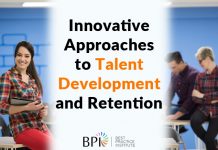The Future of HR and Work: Five Trends
The Future of HR and work involves a dual focus on humanity and technology. Best Practice Institute’s most recent survey has revealed some surprising – and essential – results that show why a focus on humanity (you guessed it: the employees) is so important. Using a global survey of over 150 employees from Fortune 1000 companies, it’s clear that employees who love their workplace are up to 4 times more likely to perform at a higher level than those who do not. Feeling respected in the workplace was the #1 reason employees loved their workplace – three times more important than compensation.
The development of a loved workplace is coming about through technology in cloud computing, apps, and analysis. Digitization, test and learns, M&As and cultural shifts within organizations will all be best utilized with the employee’s perception of the workplace in mind. The result looks to be a complete transformation of HR that is creating innovative adaptation in the areas of talent, management, and solving business problems.
- Focus on Employees
BPI’s Most Loved Workplace survey shows the significant connection between employees who are respected, engaged and valued and higher employee performance levels, greater employee retention, and a referral network initiated by the employees. This is the human side of the future of HR and work. The evidence shows the positive impacts on both the employees and the employers.
HR is the driving force in affecting the best environment for employees to thrive. They understand the importance of engaging managers who will reflect this culture of respect. Regardless of the field of work, or the professional designation, the majority of employees want to experience respect and good communication from their immediate supervisors. (3) When this is accomplished, retention is higher and turnover is lower. Employees find security in remaining in their job, and organizations must invest far less in the costs of employee turnover. These employees value their relationship with their manager more than they value any other incentive they might receive.
Iceland Foods Group has had success in providing a very positive environment for their employees – even with a retail-level pay grade employees are happier with their compensation than those at other companies with much higher pay rates. Managers are respected and reflect the corporate culture of respect. (1) This relationship between employee and manager translates into how an employee views the entire company. It is an important mandate for HR to create this environment where employees feel respected, and managers and supervisors are contributing positively to an employee’s company image. BMI’s study found that respect was the greatest motivating factor for employees.
2. Digitization is Facilitating Employee Connection
Advances in technology are enabling companies to achieve the connection between employees and job satisfaction with far less labor than previously required. (Of course, this requires the initial challenges of learning and adopting new technologies before the ‘ease’ can be experienced!)
Digitization is not an option for organizations. It is an essential component of business operations going forward. Just think back to the demise of Blockbuster alongside the rise of Netflix. Digitization is part of today’s economy. The challenge for HR is to maintain the human component as digitization progresses. This allows for input and collaboration across organizational levels and leads to happier employees who feel involved and respected within their workplaces. Digitization generally increases connection within a workplace. As Millennials take more positions within corporations, the influence of technology will increase, and provide a culture that values connection across the organization.
Coca-Cola Amantil is acknowledging the direct correlation between technology and HR by creating a new, expansive role in their HR department titled ‘general manager of people and technology’. CCA’s managing director has also espoused the value of respect for employees as most important to have them engaged in the company. It’s notable that this company is both embracing technologies as part of HR, and promoting respect in the workplace.
This increase in digitization also requires developing ongoing training and development. Current knowledge is important, but the ability to learn and adopt new innovations will be an even more valuable trait for all employees who will need to regularly update their skill sets and knowledge. Even in the very digitized world of software programming, there is a connection between happy workers and productive workers. (2) Regardless of the level of technology present, a happy employee is a productive employee.
HR is becoming empowered through apps and technologies to track performance, provide real-time feedback, and increase engagement of employees. There is also an increasing value in social media to provide increased connections throughout workplaces. These connections can be levered to increase respect and value throughout the workplace – again tapping into the most important component of many employee’s commitments to the organization they work for.
The big technologies for 2017 will be changing and evolving quickly. The ability to adapt, engage, and learn is critical to HR. Employees are looking for workplaces that will provide the best technology as part of the workplace culture. They will expect social recognition in real time, where examples of excellence, skill development, and innovation can be shared company-wide.
- Test and Learns lead to improved employee experience
Wal-Mart has created an entire test and learn team that takes their research and analytics and applies it in real life samples in-store. The result is enabling them to identify effective strategies that can then be established company-wide. This test and learn activity is also contributing to an environment of respect within the workplace. When the in-store test and learns is coupled with employee feedback about what do and do not work, AND the feedback is utilized, employees feel they are more respected within their workplace.
Applying test and learn to aspects related to employees is providing valuable feedback – both for corporations and for the employees involved in them. Companies using test and learn include Walgreens, Sunoco, dunkin’ brands, Starbucks and MacDonald’s. New software enables accurate results, real-time data, and valuable feedback from employees.
In a broader sense, companies are applying the 70-20-10 rule and are ensuring that their employees are predominantly learning through real life experience while on the job. The companies that enact versions of this rule are leading to greater employee satisfaction. Research is clear that employees prefer learning from their coworkers rather than from formal learning material and classes. This interactive, personal approach also leads to better retention and increased collaboration – ideal outcomes for HR professionals.
Every action that leads to better understanding of employees and greater respect leads towards the optimal workplace environment that facilitates increased performance, retention, and profits. When HR engages employees through test and learn and on the job training, the entire organization wins.
- The Impact of M&As
2017 will continue the trend of M&As. The responsibility for the success of an M&A is mainly on the shoulders of HR. The key to success relates back to the blend of humanity and technology. Employees thrive when they feel respected, connected, and part of an engaged corporate culture. HR will use technology to achieve this through communication and connection, analysis, and providing real-time feedback.
M&As provide an opportunity for HR to move forward with culture shifts that focus on respect of employees and creating a most loved workplace. Having a strategy prepared in advance of such major changes will improve the chances of success. Employees are one of the most important components of successful M&A, and it’s up to HR to take care of them.
- Developing a culture of respect will change everything
APT is a company providing analytical software to organizations. They’ve made it a priority to develop a workplace culture that values the employee experience, and consistently provides opportunities for teams across company levels to work together. They have been named to the U.S. Best Places to Work list for the second year in a row by Glassdoor. Glassdoor, an entirely employee led evaluation platform gives a picture into what employees can say about their workplace under the security of anonymity. An award of this order shows that employees who are respected are happy to promote their workplace.
Google has really broken the mold for employee relations in large corporations. They are consistently ranked as a top company to work for, and it’s because they treat their employees well. Although the financial compensation is impressive, employees state the culture of value and respect for employees as the reason they love working at Google.
Robert W. Baird, a financial services firm, is also highly regarded by its employees. The organization’s culture holds respect for employees as essential, and its strong performance over the past 95 years (!) is a good reflection of the value of establishing a culture of respect within a workplace.
HR must continue to be the in-house leader of flexibility, adaptability, and innovation that focuses on creating a workplace where employees will thrive. Changing bits and pieces, or only a few departments will not be enough. A colossal shift is required that will take the focus away from managing processes, and directly work towards making life better for employees.
Although technologies that are valuable to HR are changing and evolving at a rapid pace, technology in HR will continue to be important. Skills in digital areas will become increasingly essential for HR departments. The best use of new technologies will be the ability to help form Best Loved Workplaces where employees are respected, happy with their jobs, and providing an essential contribution to the success of the organization.
References
- http://www.b.co.uk/Company/Profile/306121/
- https://arxiv.org/pdf/1306.1772.pdf
- http://www.crimbbd.org/wp-content/uploads/2016/11/08.-Ishita-Nafisa.pdf
- http://www.mostlovedworkplace.com











I can relate to this. The employee-manager relationship is actually great for an increased level of employee appreciation of a job. Quite insightful. Thanks, Carter.